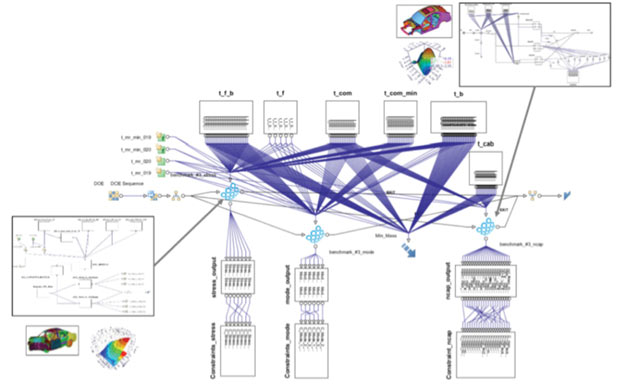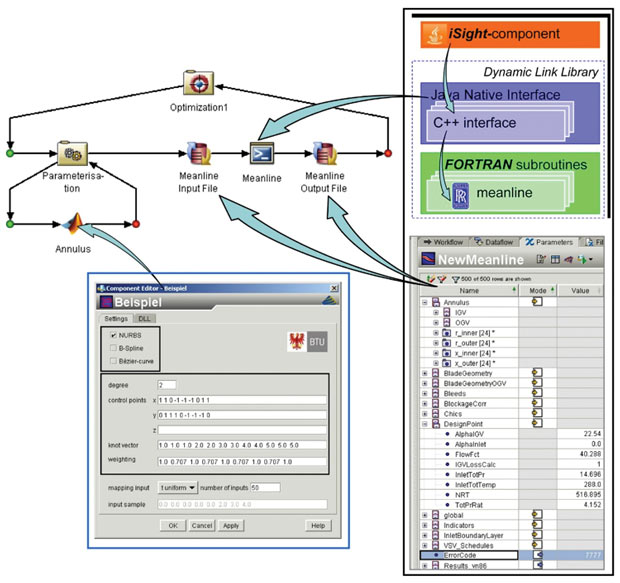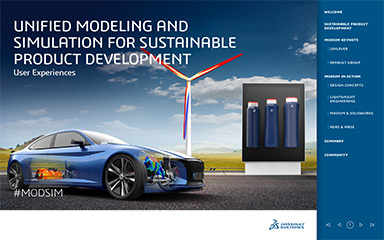
SOMO supports combining multiple projects into a multidisciplinary workflow. Image courtesy of Ford and ESTECO.
Latest News
March 1, 2016
 Design space exploration and design optimization are rapidly becoming strategic competencies that engineering organizations must master to remain competitive. To have strategic and not just tactical impact, design exploration and optimization need to be adopted and deployed within the framework of a collaborative, enterprise-wide vision.
Design space exploration and design optimization are rapidly becoming strategic competencies that engineering organizations must master to remain competitive. To have strategic and not just tactical impact, design exploration and optimization need to be adopted and deployed within the framework of a collaborative, enterprise-wide vision.
To date, however, the tools and methods are too often implemented at only the department or workgroup level, keeping their impact limited and localized. This deployment pattern is rooted in the early history of design optimization, when the discipline consisted mainly of abstruse mathematical methods that could only be applied manually by small numbers of Ph.D.-level specialists. But today the picture is different, thanks to the burgeoning number of software tools that make these powerful methods more broadly available to the engineering community.
Why should engineering organizations pursue collaborative, enterprise-level adoption of design exploration and optimization? Firstly, an enterprise-wide deployment makes the technology more readily applicable across disciplines and domains; the broader the span, the greater the impact.
Secondly, when they’re broadly deployed, these tools and methods can foster more effective “systems thinking” across project teams, helping discipline specialists raise their visibility into a project—and their contributions to it—up and out of their silo of expertise, to the systems and whole-product level.
Thirdly, and possibly most important over time, is that enterprise adoption facilitates use of these tools to capture expert knowledge from across the organization, and then to synthesize it, digitally encapsulate it and re-deploy it enterprise-wide.
Automotive and Aerospace Lead the Way
Enterprise adoption of design exploration and optimization is an indicator of an industry’s maturity level with these technologies and methods. On this measure, automakers and aircraft engine manufacturers are leading the way.
In the automotive industry, a prominent example is Ford Motor Company’s adoption of ESTECO’s SOMO software to enable what Ford calls an “enterprise multidisciplinary design optimization (MDO) system.” One key to successful adoption is a strong internal champion for the cause. Inside Ford, the driving force behind this initiative is Yan Fu, technical leader of business strategy and engineering optimization for the automaker.
Why push adoption to the enterprise level? “When an expert leaves the company or is absent from work, the entire project can run into a bottleneck,” Fu says. “The collaboration at an enterprise level guarantees the pooling of domain-specific know-how that would otherwise live inside the minds and computers of the experts themselves.” According to ESTECO, key capabilities of SOMO include: “collecting domain-specific models; integrating them into a large-scale optimization workflow; preserving and versioning all of the data in a central archive, as well as sharing results with managers and decision makers.”
 SOMO supports combining multiple projects into a multidisciplinary workflow. Image courtesy of Ford and ESTECO.
SOMO supports combining multiple projects into a multidisciplinary workflow. Image courtesy of Ford and ESTECO.Another prominent automotive example is BMW, which uses Noesis Solutions’ Optimus as its exclusive PIDO (process integration and design optimization) solution. With a large number of licenses installed and many trained users, the automaker standardized on Optimus because of its flexibility and its capability as an enterprise solution, reports Markus Zimmerman, director of Research at BMW.
Starting with full-vehicle early-phase concept optimization, the software is used throughout the product development process for system-level optimization as well as component optimization across NVH (noise, vibration and harshness), structural dynamics, crash, systems engineering, R&D and other areas of vehicle design and development.
Aircraft engines are another industry where leading manufacturers have achieved enterprise-level adoption. A prominent example is Rolls-Royce, well known for its longstanding institutionalization of design exploration, optimization and process integration based on the Isight software from Dassault Systèmes’ SIMULIA. Alexander Karl, robust design lead with Rolls-Royce, explains how its robust design program emphasizes the role of design as the entry-point into its enterprise Six Sigma initiative: “We realized early on that the sheer size and complexity of the aircraft engine design and development ‘problem’ could only be mastered through a combination of simulation, process automation and optimization.”
 By creating Isight components for automating tasks in the compressor meanline prediction portion of the aircraft engine design iteration loop, complex analyses can be condensed into user-friendly drop-ins. Image courtesy of Rolls-Royce.
By creating Isight components for automating tasks in the compressor meanline prediction portion of the aircraft engine design iteration loop, complex analyses can be condensed into user-friendly drop-ins. Image courtesy of Rolls-Royce.“We have been using Isight software as our main toolkit for robust design for almost a decade,” Karl said in 2010. “At first, our management approached this new technology with caution, but our early successes with it convinced them of the value of standardizing on a single solution instead of growing lots of different solutions. Once it was realized that process integration and automation could be a cost driver for manufacturing, everyone was on board.”
Subscribe to our FREE magazine, FREE email newsletters or both!
Latest News
About the Author
Bruce Jenkins is president of Ora Research (oraresearch.com), a research and advisory services firm focused on technology business strategy for 21st-century engineering practice.
Follow DE





